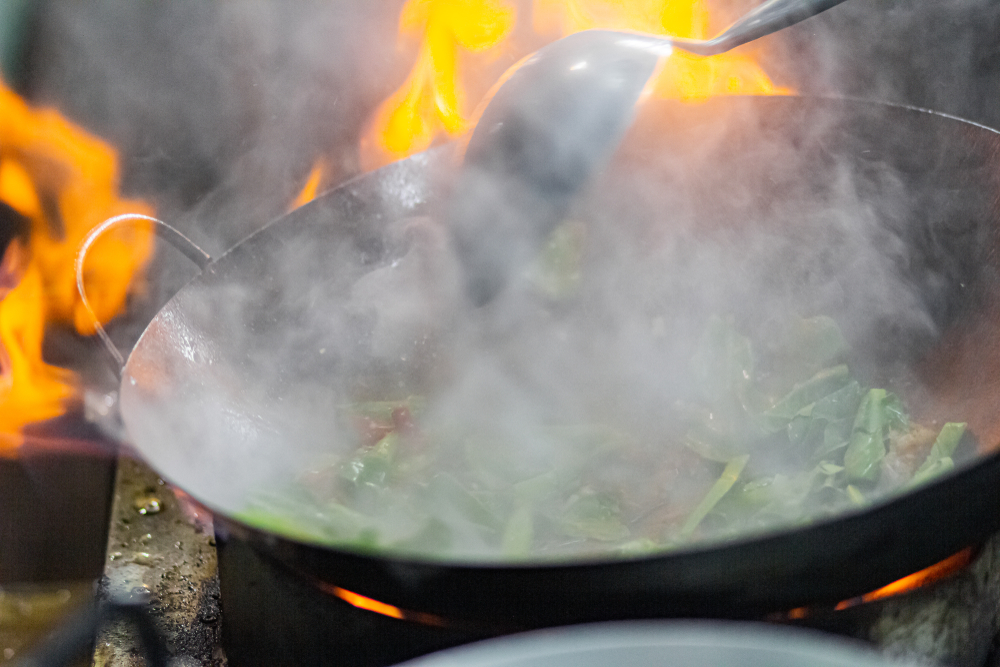That delicious smell of onions sautéing or bacon crisping up in the pan might make your mouth water, but your lungs might not be as thrilled. While we’ve been busy worrying about outdoor air pollution, traffic fumes, and secondhand smoke, we’ve been largely ignoring a potential health risk that’s been wafting around our kitchens for generations. Those cooking oil fumes that make dinner smell so good? They might be doing more than just making your house smell like a restaurant.
The invisible byproduct of your favorite meals
Every time you heat cooking oil to high temperatures, especially when it starts smoking, you’re creating a complex mixture of chemicals that float through your kitchen and into your respiratory system. That appetizing sizzle comes with a side of particulate matter, aldehydes, polycyclic aromatic hydrocarbons, and other compounds with intimidating names and potentially concerning health effects.
Think about it. When was the last time you deep-fried something and the kitchen didn’t fill with visible smoke? Or when you seared meat in a hot pan and didn’t set off the smoke detector? That visual and olfactory evidence isn’t just an annoying byproduct of cooking but a signal that your indoor air quality has temporarily tanked.
The average kitchen during a cooking session can have particle levels that would exceed outdoor air quality standards if measured by the same criteria. And unlike outdoor pollution, which at least has some chance to disperse, these cooking fumes can remain concentrated in your home, especially if ventilation is poor.
Why we’ve been turning a blind eye
It’s easy to understand why cooking oil fumes haven’t gotten much attention. For one thing, cooking is essential, and using oils and fats is deeply embedded in virtually every culinary tradition worldwide. The idea that something so fundamental to human existence could be problematic feels almost heretical.
Then there’s the sensory aspect. Unlike cigarette smoke, which most people find unpleasant even if they’re smokers themselves, cooking oil fumes usually smell delicious. Our brains associate these smells with comfort, nourishment, and pleasure. It’s hard to think something that smells so good could be bad for us.
There’s also a practical element at play. We all need to eat, and many of our favorite foods require frying or sautéing. Suggesting that these cooking methods might be problematic feels like yet another thing to worry about in a world already full of health concerns.
But just as we’ve come to recognize other environmental health risks that were once overlooked, from lead paint to radon, it may be time to take a closer look at what’s happening in our kitchens.
The science behind the smoke
When cooking oils heat up, especially past their smoke point, they begin to break down and oxidize, releasing a mixture of chemicals into the air. The composition varies depending on the type of oil, how hot it gets, and how long it’s heated, but the mixture typically includes:
- Fine particulate matter small enough to penetrate deep into the lungs.
- Volatile organic compounds that can irritate the respiratory system.
- Polycyclic aromatic hydrocarbons, some of which are known carcinogens.
- Aldehydes like acrolein that can cause irritation to the eyes and respiratory tract.
These aren’t just theoretical concerns. Hospital workers who spend their days in poorly ventilated cafeterias where frying occurs regularly have shown higher rates of respiratory symptoms. Home cooks in cultures where oil-heavy cooking methods dominate have higher rates of certain respiratory conditions.
The worst offenders tend to be oils heated to very high temperatures during processes like deep-frying, especially when the same oil is reused multiple times. Each reheating breaks the oil down further, creating more potentially harmful compounds.
Not all cooking methods are created equal
The good news is that not all cooking creates significant fumes. The risk scale runs roughly from lowest to highest like this:
- Boiling and steaming produce minimal harmful emissions.
- Light sautéing at medium heat creates moderate emissions.
- Stir-frying at high heat generates significant fumes.
- Deep-frying produces the highest levels of potentially harmful compounds.
The type of oil matters too. Generally speaking, oils with higher smoke points like avocado oil tend to produce fewer harmful compounds when heated compared to oils with lower smoke points like flaxseed oil. But even high smoke point oils will break down and release potentially harmful compounds if heated enough.
What you’re cooking also plays a role. Protein-rich foods like meat can create additional compounds when their proteins and fats interact with hot oil. That’s why the smell of bacon cooking is so distinctive and powerful, but also why it creates more particulate matter in your kitchen air.
The potential health impact
Breathing in cooking oil fumes regularly over long periods might contribute to a range of health issues:
- Respiratory symptoms like coughing, wheezing, and shortness of breath.
- Reduced lung function over time Increased risk of respiratory infections.
- Potential increased risk of certain cancers, particularly lung cancer.
- Exacerbation of existing conditions like asthma and COPD.
Children may be particularly vulnerable, as their lungs are still developing and they breathe more air relative to their body size than adults do. People with pre-existing respiratory conditions are also at higher risk of experiencing symptoms from exposure to cooking fumes.
The most compelling evidence comes from parts of the world where cooking with oils at very high temperatures is a daily practice, often in poorly ventilated spaces. In these regions, nonsmoking women who cook using these methods show lung cancer rates similar to passive smokers.
Of course, most home cooks in well-ventilated modern kitchens aren’t facing risks anywhere near this severe. The occasional stir-fry or pan of bacon isn’t going to dramatically impact your health. But for people who cook with oil at high temperatures daily or those with respiratory sensitivities, the cumulative exposure might be worth considering.
Simple ways to clear the air
Before you swear off cooking forever, there are plenty of practical steps you can take to reduce your exposure to cooking oil fumes without sacrificing your favorite foods:
- Use your range hood fan every time you cook, and make sure it vents to the outside rather than just recirculating air through a filter.
- Open windows when cooking to improve ventilation, even in winter if possible.
- Consider using air purifiers with HEPA filters in your kitchen.
- Choose cooking oils with higher smoke points when using high-heat methods.
- Avoid overheating oils to the point where they smoke visibly.
- Try cooking methods that produce fewer fumes, like steaming, boiling, or baking.
- Clean your stovetop regularly to prevent buildup of oil that can smoke when heated.
- Consider reducing the frequency of high-temperature frying, saving it for special occasions.
For those who love the taste of fried foods but want to reduce their exposure to fumes, air fryers offer an interesting alternative. They create the crispy texture many people love while producing fewer fumes since they use less oil and often contain the cooking process better than open pans.
Induction cooktops may also help, as they heat more efficiently and allow for more precise temperature control, making it easier to keep oils below their smoke point while still cooking effectively.
Finding a balanced approach
As with many health considerations, the key is finding a balance that works for your lifestyle, preferences, and risk factors. Food is not just fuel but also an important source of pleasure, cultural connection, and social bonding. Any approach to reducing cooking fumes should take these factors into account.
If you’re generally healthy, have good ventilation in your kitchen, and don’t fry foods at high temperatures daily, your risk from cooking oil fumes is likely minimal. Making small changes like using your hood fan consistently and opening windows when cooking might be sufficient.
For those with existing respiratory conditions or those who cook with oils at high temperatures very frequently, more significant changes might be worth considering, like exploring different cooking methods or investing in better ventilation or air filtration.
The goal isn’t to create fear around cooking but to raise awareness of a potential risk factor that’s been largely overlooked and to empower people with practical ways to reduce their exposure if they choose to.
Beyond personal choices
While individual actions can help reduce exposure, there are also broader implications for how we design living spaces. Many apartment buildings have inadequate kitchen ventilation, particularly in affordable housing. Better building codes and renovation standards could help ensure that all kitchens have effective ventilation systems that vent to the outside.
There’s also room for more public awareness about the importance of using range hoods and other ventilation methods. Many people have range hoods but don’t use them consistently or don’t maintain them properly, reducing their effectiveness.
For those building or renovating kitchens, considering the placement and power of ventilation systems is as important as choosing countertops or appliances. A beautiful kitchen that fills with smoke every time you cook isn’t ultimately a functional one, no matter how good it looks.
The more we understand about indoor air quality, the more we can make informed choices about how we cook and how we design our homes. That sizzling pan might always be a part of our culinary lives, but with some thoughtful adjustments, we can enjoy the foods we love while minimizing the potential downsides of cooking fumes.
After all, the goal of cooking isn’t just to create delicious food but to nourish ourselves and those we care about. Taking steps to make the cooking process itself healthier aligns perfectly with that goal.















